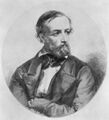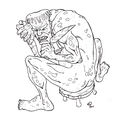Template:Selected anniversaries/July 27: Difference between revisions
No edit summary |
No edit summary |
||
| Line 20: | Line 20: | ||
||1849: John Hopkinson born ... physicist and electrical engineer who worked on the application of electricity and magnetism in devices like the dynamo and electromagnets. Hopkinson's law (the magnetic equivalent of Ohm's law) bears his name. In 1882, he patented his invention of the three-wire system (three phase) for electricity generation and distribution. He presented the principle the synchronous motors (1883), and designed electric generators with better efficiency. He also studied condensers and the phenomena of residual load. In his earlier career, he became (1872) engineering manager of Chance Brothers and Co., a glass manufacturer in Birmingham, where he studied lighthouse illumination, improving efficiency with flashing groups of lights. Pic: https://es.wikipedia.org/wiki/John_Hopkinson | ||1849: John Hopkinson born ... physicist and electrical engineer who worked on the application of electricity and magnetism in devices like the dynamo and electromagnets. Hopkinson's law (the magnetic equivalent of Ohm's law) bears his name. In 1882, he patented his invention of the three-wire system (three phase) for electricity generation and distribution. He presented the principle the synchronous motors (1883), and designed electric generators with better efficiency. He also studied condensers and the phenomena of residual load. In his earlier career, he became (1872) engineering manager of Chance Brothers and Co., a glass manufacturer in Birmingham, where he studied lighthouse illumination, improving efficiency with flashing groups of lights. Pic: https://es.wikipedia.org/wiki/John_Hopkinson | ||
||1866 | ||1866: The first permanent transatlantic telegraph cable is successfully completed, stretching from Valentia Island, Ireland, to Heart's Content, Newfoundland. | ||
||Derrick Norman Lehmer | ||1867: Derrick Norman Lehmer born ... mathematician and number theorist. Pic. | ||
File:Ernst Zermelo 1900s.jpg|link=Ernst Zermelo (nonfiction)|1871: Logician and mathematician [[Ernst Zermelo (nonfiction)|Ernst Friedrich Ferdinand Zermelo]] born. His work will have major implications for the foundations of mathematics; he will be known for his role in developing Zermelo–Fraenkel axiomatic set theory, and for his proof of the well-ordering theorem. | File:Ernst Zermelo 1900s.jpg|link=Ernst Zermelo (nonfiction)|1871: Logician and mathematician [[Ernst Zermelo (nonfiction)|Ernst Friedrich Ferdinand Zermelo]] born. His work will have major implications for the foundations of mathematics; he will be known for his role in developing Zermelo–Fraenkel axiomatic set theory, and for his proof of the well-ordering theorem. | ||
||1881 | ||1881: Hans Fischer born ... chemist and academic, Nobel Prize laureate. | ||
||1882 | ||1882: Geoffrey de Havilland born ... pilot and engineer, founded the de Havilland Aircraft Company. | ||
||1890 | ||1890: Vincent van Gogh shoots himself and dies two days later. | ||
||Allen Goodrich Shenstone | ||1893: Allen Goodrich Shenstone born ... physicist. He earned bachelor's, master's, and Ph.D. degrees from Princeton University, as well as a Bachelor of Arts from the University of Cambridge. After a brief stint as a junior faculty member at the University of Toronto, he returned to Princeton, where he was a professor in the Department of Physics 1925–62. He chaired the department 1949–60. He worked primarily in the field of atomic spectroscopy | ||
File:Hendrik_Antoon_Lorentz.jpg|link=Hendrik Lorentz (nonfiction)|1904: Physicist and crime-fighter [[Hendrik Lorentz (nonfiction)|Hendrik Lorentz]] uses the Zeeman effect to detect and prevent [[crimes against mathematical constants]]. | File:Hendrik_Antoon_Lorentz.jpg|link=Hendrik Lorentz (nonfiction)|1904: Physicist and crime-fighter [[Hendrik Lorentz (nonfiction)|Hendrik Lorentz]] uses the Zeeman effect to detect and prevent [[crimes against mathematical constants]]. | ||
||Kenneth Tompkins Bainbridge | ||1904: Kenneth Tompkins Bainbridge born ... physicist at Harvard University who did work on cyclotron research. His precise measurements of mass differences between nuclear isotopes allowed him to confirm Albert Einstein's mass-energy equivalence concept. He was the Director of the Manhattan Project's Trinity nuclear test, which took place July 16, 1945. Bainbridge described the Trinity explosion as a "foul and awesome display". He remarked to J. Robert Oppenheimer immediately after the test, "Now we are all sons of bitches." | ||
||1907 | ||1907: Irene Fischer born ... geodesist and mathematician. | ||
||1917 | ||1917: Emil Theodor Kocher dies ... physician and academic, Nobel Prize laureate. | ||
||1921 – Researchers at the University of Toronto, led by biochemist Frederick Banting, prove that the hormone insulin regulates blood sugar. | ||1921 – Researchers at the University of Toronto, led by biochemist Frederick Banting, prove that the hormone insulin regulates blood sugar. | ||
||Yuri Nikolaevich Denisyuk | ||1927: Yuri Nikolaevich Denisyuk born ... physicist, one of the founders of optical holography. He is known for his great contribution to holography, in particular for the so-called "Denisyuk hologram". Pic. | ||
File:John Ambrose Fleming 1890.png|link=John Ambrose Fleming (nonfiction)|1928: Electrical engineer and physicist [[John Ambrose Fleming (nonfiction)|John Ambrose Fleming]] marries the popular young singer Olive May Franks of Bristol. | File:John Ambrose Fleming 1890.png|link=John Ambrose Fleming (nonfiction)|1928: Electrical engineer and physicist [[John Ambrose Fleming (nonfiction)|John Ambrose Fleming]] marries the popular young singer Olive May Franks of Bristol. | ||
|1931 | ||1931: Auguste Forel dies ... neuroanatomist and psychiatrist. | ||
File:Edmund Husserl 1910s.jpg|link=Edmund Husserl (nonfiction)|1938: Mathematician and philosopher [[Edmund Husserl (nonfiction)|Edmund Husserl]] publishes new class of [[Gnomon algorithm functions]] based on transcendental consciousness as the limit of all possible knowledge. | File:Edmund Husserl 1910s.jpg|link=Edmund Husserl (nonfiction)|1938: Mathematician and philosopher [[Edmund Husserl (nonfiction)|Edmund Husserl]] publishes new class of [[Gnomon algorithm functions]] based on transcendental consciousness as the limit of all possible knowledge. | ||
| Line 55: | Line 55: | ||
He will co-create the pioneering role-playing game [[Dungeons & Dragons (nonfiction)|Dungeons & Dragons]] (D&D) with Dave Arneson. | He will co-create the pioneering role-playing game [[Dungeons & Dragons (nonfiction)|Dungeons & Dragons]] (D&D) with Dave Arneson. | ||
||1949 | ||1949: Initial flight of the de Havilland Comet, the first jet-powered airliner. | ||
||1951 | ||1951: Paul Kogerman dies ... chemist and politician. | ||
||1960 | ||1960: Julie Vinter Hansen dies ... astronomer and academic. | ||
File:Cantor Parabola.jpg|link=Cantor Parabola|1973: Math photographer [[Cantor Parabola]] takes advance photographs of the House of Representatives Judiciary Committee voting to recommend the first article of impeachment against President Nixon. | File:Cantor Parabola.jpg|link=Cantor Parabola|1973: Math photographer [[Cantor Parabola]] takes advance photographs of the House of Representatives Judiciary Committee voting to recommend the first article of impeachment against President Nixon. | ||
| Line 67: | Line 67: | ||
File:Culvert Origenes.jpg|link=Culvert Origenes|1974: Writer and philosopher [[Culvert Origenes]] says that "it's about time the House Judiciary Committee got busy impeaching Nixon." | File:Culvert Origenes.jpg|link=Culvert Origenes|1974: Writer and philosopher [[Culvert Origenes]] says that "it's about time the House Judiciary Committee got busy impeaching Nixon." | ||
|| | ||1987: Jan Mikusiński dies ... mathematician based at the University of Wrocław known for his pioneering work in mathematical analysis. Mikusiński developed an operational calculus – known as the Calculus of Mikusiński (MSC 44A40), which is relevant for solving differential equations. His operational calculus is based upon an algebra of the convolution of functions with respect to the Fourier transform. From the convolution product he goes on to define what in other contexts is called the field of fractions or a quotient field. These ordered pairs of functions Mikusiński calls operators – Mikusiński Operator. Pic: http://www.math.us.edu.pl/instytut/historia/mikusinski/mikusinski.html | ||
||1999 | ||1988: Frank Zamboni dies ... inventor and businessman, founded the Zamboni Company. | ||
||1999: Aleksandr Danilovich Aleksandrov dies ... mathematician, physicist, and mountaineer. | |||
</gallery> | </gallery> | ||
Revision as of 08:40, 3 September 2018
1801: Mathematician and astronomer George Biddell Airy born. His achievements will include work on planetary orbits, measuring the mean density of the Earth, and, in his role as Astronomer Royal, establishing Greenwich as the location of the prime meridian.
1837: Peter Dirichlet presented his first analytic number theory paper at a meeting of the Berlin Academy of Sciences. He proved the fundamental theorem that bears his name: Every arithmetical sequence an + b, n = 0, 1, 2, ... of integers, where a and b are relatively prime, contains infinitely many primes.
1844: Chemist, meteorologist, and physicist John Dalton dies. He proposed the modern atomic theory, and did research in color blindness.
1871: Logician and mathematician Ernst Friedrich Ferdinand Zermelo born. His work will have major implications for the foundations of mathematics; he will be known for his role in developing Zermelo–Fraenkel axiomatic set theory, and for his proof of the well-ordering theorem.
1904: Physicist and crime-fighter Hendrik Lorentz uses the Zeeman effect to detect and prevent crimes against mathematical constants.
1928: Electrical engineer and physicist John Ambrose Fleming marries the popular young singer Olive May Franks of Bristol.
1938: Mathematician and philosopher Edmund Husserl publishes new class of Gnomon algorithm functions based on transcendental consciousness as the limit of all possible knowledge.
1938: Game designer Gary Gygax born.
1973: Math photographer Cantor Parabola takes advance photographs of the House of Representatives Judiciary Committee voting to recommend the first article of impeachment against President Nixon.
1974: Watergate scandal (nonfiction): The House of Representatives Judiciary Committee votes 27 to 11 to recommend the first article of impeachment (for obstruction of justice) against President Richard Nixon.
1974: Writer and philosopher Culvert Origenes says that "it's about time the House Judiciary Committee got busy impeaching Nixon."










